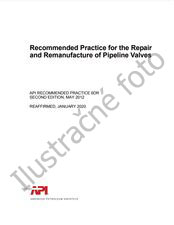Potrebujeme váš súhlas na využitie jednotlivých dát, aby sa vám okrem iného mohli ukazovať informácie týkajúce sa vašich záujmov. Súhlas udelíte kliknutím na tlačidlo „OK“.

API DR 148-ed.1997
HEALTH AND ENVIRONMENTAL SCIENCES DEPARTMENTAL REPORT - IDENTIFICATION OF ORGANIC TOXICANTS IN TREATED REFINERY EFFLUENTS
NORMA vydaná dňa 1.12.1997
Informácie o norme:
Označenie normy: API DR 148-ed.1997
Dátum vydania normy: 1.12.1997
Kód tovaru: NS-1139447
Počet strán: 63
Približná hmotnosť: 189 g (0.42 libier)
Krajina: Americká technická norma
Kategória: Technické normy API
Anotácia textu normy API DR 148-ed.1997 :
API DR 148, 1997 Edition, December 1997 - HEALTH AND ENVIRONMENTAL SCIENCES DEPARTMENTAL REPORT - IDENTIFICATION OF ORGANIC TOXICANTS IN TREATED REFINERY EFFLUENTS
OBJECTIVES AND SCOPE
Toxicity characterization procedures with either larval fathead minnow (Pimephales promelus) or (Mysidopsis bahia) were performed with effluents from five refineries to identify nonpolar organics responsible for chronic toxicity. Test species selected for this study are also commonly used for determining compliance with effluent discharge toxicity limits. Any toxicity caused by more easily recognized substances, such as ammonia, was not of concern.
Characteristics of selected refinery effluents were initially examined to determine suitable effluents for identification of nonpolar organic toxicants. Nonpolar organic toxicants were operationally defined as those adsorbed by C18 SPE columns. Desirable effluent characteristics were: 1) consistent presence of measurable chronic toxicity due to nonpolar organic compounds; and 2) a lack of toxicity from compounds other than nonpolar organics. Samples with these characteristics were preferred to minimize difficulties in tracking effluent toxicity through sample manipulations and to reduce the possibility of artifacts from the multiple treatments required to address toxicants belonging to more than one class of compounds.
Historically, several common difficulties have been encountered during identification of nonpolar organic toxicants in refinery effluents. Past problems included: 1) poor recovery of toxicity from C 18 solid phase extraction (SPE) columns, 2) poor resolution of toxicity during separative steps, 3) failure to recover toxicity following high performance liquid chromatography (HPLC) separation, and 4) inability to adequately simplify effluent fractions containing the nonpolar organic toxicants. Procedures were employed to: 1) simplify the toxic nonpolar organic effluent fraction, 2) achieve sufficient toxicant concentration to allow analytical measurement, and 3) remove water from the fraction to allow analysis by gas chromatography/mass spectroscopy (GUMS). GC analyses are often not definitive because of the hydrocarbon content of refinery effluents. To overcome these difficulties, modifications of the U.S. EPAs suggested guidance for Phase II Toxicity Identification Evaluation (TIE) procedures (U.S. EPA 1993) for nonpolar organic compounds were developed and tried.
Odporúčame:
Aktualizácia technických noriem
Chcete mať istotu, že používate len platné technické normy?
Ponúkame Vám riešenie, ktoré Vám zaistí mesačný prehľad o aktuálnosti noriem, ktoré používate.
Chcete vedieť viac informácií ? Pozrite sa na túto stránku.



 Cookies
Cookies
